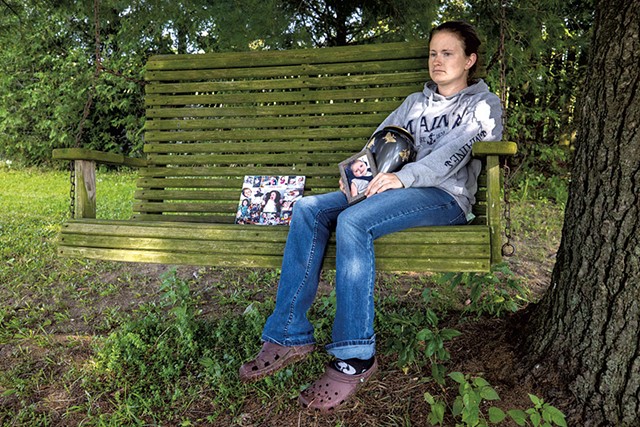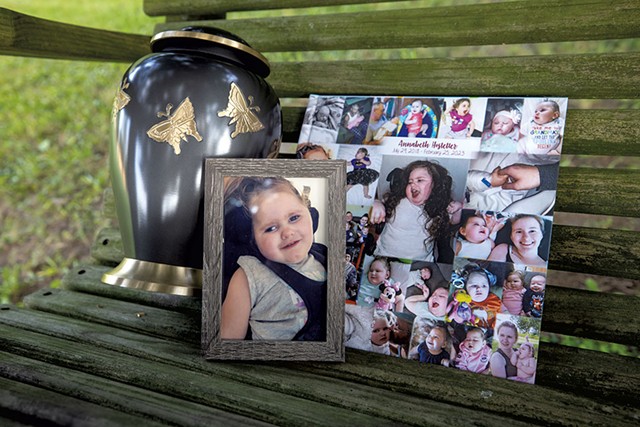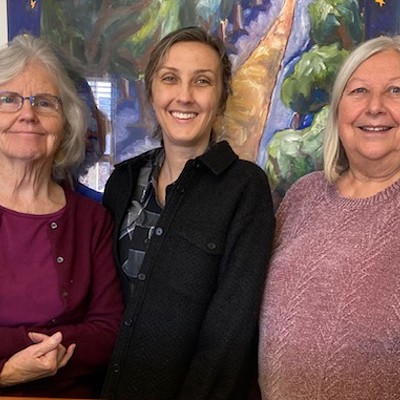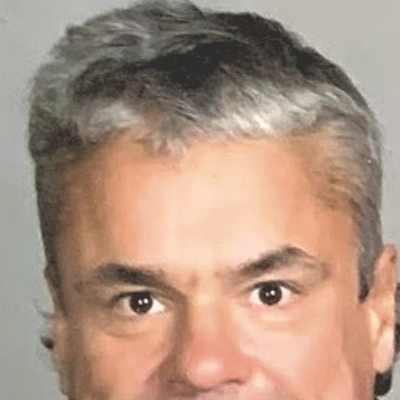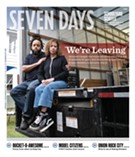Switch to the mobile version of this page.
Vermont's Independent Voice
- News
- Arts+Culture
- Home+Design
- Food
- Cannabis
- Music
- On Screen
- Events
- Jobs
- Obituaries
- Classifieds
- Personals
Browse News
Departments
Browse Arts + Culture
View All
local resources
Browse Food + Drink
View All
Browse Cannabis
View All
-
Culture

'Cannasations' Podcaster Kris Brown Aims to 'Humanize'…
-
True 802

A Burlington Cannabis Shop Plans to Host…
-
Business

Judge Tosses Burlington Cannabiz Owner's Lawsuit
-
Health + Fitness

Vermont's Cannabis Nurse Hotline Answers Health Questions…
-
Business

Waterbury Couple Buy Rare Vermont Cannabis License
Browse Music
View All
Browse On Screen
Browse Events
Browse Classifieds
Browse Personals
-

If you're looking for "I Spys," dating or LTRs, this is your scene.
View Profiles
Special Reports
Pubs+More
Behind a $3.5 Million Medical Malpractice Settlement Is the Story of a Disabled Child and a Devoted Mom
Published September 27, 2023 at 10:00 a.m.
Ashley Hostetter took a deep breath and opened the box. Months had passed since she looked inside, but she knew its contents intimately. An impossibly small hospital band. Anger-provoking medical records. Most painful of all, the baby book.
Hostetter flipped to the page that tallied her emotions when she learned she was pregnant. Her 18-year-old self had checked off every box: excited, shocked, ecstatic, scared. She had added, in her own writing, two more: "joy and love."
On the birth page, her neat, bubbly script detailed the life she had just created: July 29, 2018, 10:01 a.m.; six pounds, nine ounces; 21 inches. Hostetter taped a photo of her newborn and recorded her name: Annabeth Rose Hostetter.
The entries slowed after that. No first words, nor first steps. No first solid foods or favorite songs. No photos from kindergarten.
"There wasn't much else I could fill out," Hostetter said, turning the blank pages, "because she wasn't a normal child."
In the days after her birth, Annabeth slipped into a septic crisis, an immune response to infection that can be lethal if not caught in time, and suffered multiple strokes that left her brain severely damaged. She'd survive, against all odds, through endless illnesses, until her death in February at age 4.
Hostetter brought Annabeth to Gifford Medical Center every day the week after her birth, worried that she was lethargic and not eating. She said doctors repeatedly dismissed her concerns and sent her home.
In 2021, after years of near-constant medical crisis, she filed a medical malpractice lawsuit, alleging that Gifford's pediatric doctors had failed to diagnose her newborn's condition despite blood work suggesting that she was battling an infection. Hostetter believed the doctors had ignored her concerns because she was young.
As a federally qualified health center, Gifford's pediatric clinic receives funding from the U.S. government, which technically makes its doctors federal employees under tort laws. As a result, the U.S. Department of Justice assumed the defense and ultimately agreed to settle the case in the spring for $3.5 million.
The agreement, which contains no admission of wrongdoing, appears to be an unusually high payout for medical malpractice in Vermont. Gifford Medical Center did not respond to requests for comment.
Hostetter, who has three other children under age 5, said the settlement will allow her family to live more comfortably. Yet it won't fill the hole that Annabeth's death has left.
"Money is money," she said, wiping away tears, "but family meant everything to me."
That's been true ever since she was a young girl dreaming of a big family of her own one day. Whenever she was asked how many kids she might want, she'd say: "As many as God will give me — or at least 10."
Her first pregnancy ended in a miscarriage. Six weeks later, she was pregnant again, this time with Annabeth.
The newborn seemed lethargic and had not latched on to Hostetter's breast by the time they were due to head home in July 2018. But the doctors assured the mother that this was normal for babies who arrived a few weeks early. They discharged her and offered to connect her with a home health aide who could follow up about feeding techniques.
During one of Hostetter's repeated hospital visits the following week, Annabeth's pediatrician weighed her and found that she had lost nearly a pound. The message was the same, though: This happens; she'll be fine.
On the eighth day after their discharge, Hostetter noticed that Annabeth's breathing had become labored. She took her back to the emergency department, determined to get answers. At reception, she placed Annabeth's car seat on a chair and spoke to the check-in nurse. That's when Annabeth stopped breathing.
The baby was rushed to the emergency department, where doctors performed an emergency spinal tap. Hostetter knew from a brief time working as a licensed nurse assistant that the fluid should have been clear. Instead, she said, it looked like "chunky, curdled milk."
Annabeth suffered multiple strokes and went minutes without a pulse, depriving her brain of oxygen. Later, at Dartmouth-Hitchcock Medical Center, scans showed that half of her brain was no longer working. Doctors told Hostetter her baby would be lucky to survive 24 hours. But Annabeth, who was placed on a ventilator, made it through the day, then the next. Six months later, following numerous surgeries, she was sent home.
Doctors would later determine that Hostetter had passed a bacterial flu infection onto Annabeth during the delivery. That led to meningitis — the swelling of tissue covering the brain and spinal cord.
The brain damage had affected Annabeth's vision. At home, she was immobilized and had near-constant seizures, despite strong medications. She suffered from constant respiratory problems and would need several more surgeries on her brain. She would remain at the developmental level of a 3-month-old for the rest of her short life.
Hostetter took advantage of the time she had with her "miracle baby." When Annabeth turned 1, her mother threw a big party, knowing that the child might not live to see another birthday. Hostetter dressed her up each Halloween, cutting holes in the costumes to accommodate an IV tube.
Meanwhile, Hostetter weighed her legal options, convinced Annabeth's condition should have been prevented. She eventually called Harding Mazzotti — a New York firm with an office in southern Vermont — where she was connected with attorney Amelia Silver.
Tens of thousands of deaths in the U.S. are blamed on medical errors each year, but malpractice cases are exceedingly difficult to prove. Plaintiffs must show not only that doctors made a mistake but that they also failed to provide a proper standard of care.
Very few calls that Harding Mazzotti receives about medical malpractice get past an initial screening, Silver said. Any case that she believes may be worth pursuing gets sent to an outside medical professional for review.
Not long after sending off Annabeth's files, Silver got her answer: This shouldn't have happened. Two other specialists told her the same thing.
Silver filed a notice with the federal government in July 2020 seeking compensation for her clients. When the Department of Justice denied the claim, she sued in federal court.
The justice department found its own highly credentialed witnesses, who argued in depositions that the doctors did meet the standard of care. If the case went to trial, it would come down to a battle of experts.
And because federal law requires claims against the U.S. government to be decided in bench trials, it would be a judge — not a jury — who would make the ultimate decision. That was a risky bet. Hostetter and her ex-husband decided to settle.
A wealth management consultant helped estimate Annabeth's future medical costs. The government came up with its own numbers. In the end, the two sides agreed to $7 million.
The settlement was almost complete in February when Hostetter took Annabeth to the hospital for a checkup. The girl had been having trouble breathing, and Hostetter suspected she was experiencing another bout of aspiration pneumonia, a common ailment among children with compromised immune systems. It turned out that the 4-year-old had come down with a serious respiratory virus: RSV.
Hostetter's stomach dropped. The child had already beaten COVID-19 twice, but RSV was, in Hostetter's eyes, more ominous: The first funeral she ever attended was for a young cousin who had succumbed to it. She braced for the worst.
Annabeth's oxygen levels fell that evening. The next morning, she was put on end-of-life care. Hostetter took her home and, with the help of a hospice nurse, tried to make her comfortable.
Hostetter's attorneys were racing to hash out the details of a complex 40-page agreement that described how the settlement would be paid out. Half of the money was to be placed into a trust to help Annabeth's parents care for her. The other half would be retained by the feds to pay for her health insurance and other medical costs.
The funds were put into an escrow account on a Friday in late February, and the deal was expected to be completed within days. That same weekend, though, Annabeth died.
Her death nullified the deal in the eyes of the justice department, which maintained that Annabeth had to be alive at the time of the settlement's conclusion. Hostetter's attorneys disputed that interpretation, but the feds wouldn't budge.
Litigating the disagreement could have taken years. Hostetter, meanwhile, had entered a contract to purchase a home with her fiancé in anticipation of the settlement. She and her ex-husband agreed to start the process over — this time, as a wrongful death claim.
Three months later, the feds agreed to a second settlement worth half of the original. In June, Hostetter received her share.
She put some money toward a $365,000 house in Swanton and its renovation, which is ongoing. She also bought a car to replace the run-down white van she had used to shuttle Annabeth to appointments. The rest will help her family live more comfortably, but it's not enough to get by on forever, she said. She expects to seek work eventually. For now, though, she's trying to adjust to life without Annabeth, who used to occupy her every waking moment.
Hostetter, now 24, has channeled her time and energy into her surviving children. They spent so many nights away from her during Annabeth's long hospital stays that they sometimes seem to think that Hostetter's parents are their own.
When her oldest, Samuel, 4, mentions his sister, Hostetter tells him it's OK to be sad. "Mommy misses her, too," she says. At times her own grief overwhelms her, and she must sneak outside to compose herself. Most nights, Hostetter said, she cries herself to sleep.
"It gets pretty dark sometimes," she said.
During Annabeth's final days, Hostetter decided to do one final thing for her daughter — and herself. A friend who ran a tattoo parlor had a last-minute opening. Hostetter slipped out of the house briefly while the hospice nurse took over. She returned a couple of hours later with her forearm bandaged.
Beneath it was a tattoo replicating one of her favorite photos, of Annabeth holding a Minnie Mouse doll tight to her chest. It was her second tattoo inspired by her daughter. The other, on her shoulder, depicts half a brain and half a heart, coming together as one.
The original print version of this article was headlined "'Miracle Baby' | Behind a $3.5 million medical malpractice settlement is the story of a disabled child and a devoted mom"
Got something to say?
Send a letter to the editor
and we'll publish your feedback in print!
Tags: Health Care
More By This Author
About The Author

Colin Flanders
Bio:
Colin Flanders is a political reporter at Seven Days, covering the Statehouse. He previously worked as a reporter at a group of Chittenden County weekly newspapers covering Essex, Milton and Colchester.
Colin Flanders is a political reporter at Seven Days, covering the Statehouse. He previously worked as a reporter at a group of Chittenden County weekly newspapers covering Essex, Milton and Colchester.
About the Artist

James Buck
Bio:
James Buck is a multimedia journalist for Seven Days.
James Buck is a multimedia journalist for Seven Days.
Comments
Comments are closed.
From 2014-2020, Seven Days allowed readers to comment on all stories posted on our website. While we've appreciated the suggestions and insights, right now Seven Days is prioritizing our core mission — producing high-quality, responsible local journalism — over moderating online debates between readers.
To criticize, correct or praise our reporting, please send us a letter to the editor or send us a tip. We’ll check it out and report the results.
Online comments may return when we have better tech tools for managing them. Thanks for reading.
- 1. 'We're Leaving': Winooski's Bargain Real Estate Attracted a Diverse Group of Residents for Years. Now They're Being Squeezed Out. Housing Crisis
- 2. Aggressive Behavior, Increased Drug Use at Burlington's Downtown Library Prompt Calls for Help City
- 3. High School Snowboarder's Nonprofit Pitch Wins Her Free Tuition at UVM True 802
- 4. Through Arts Such as Weaving, Older Vermonters Reflect on Their Lives and Losses This Old State
- 5. Vermont Senate Votes Down Ed Secretary Nominee Zoie Saunders Education
- 6. An Act 250 Bill Would Fast-Track Approval of Downtown Housing While Protecting Natural Areas Environment
- 7. Overdose-Prevention Site Bill Advances in the Vermont Senate News
- 1. Totally Transfixed: A Rare Eclipse on a Bluebird Day Dazzled Crowds in Northern Vermont 2024 Solar Eclipse
- 2. Zoie Saunders, Gov. Scott’s Pick for Education Secretary, Faces Questions About Her Qualifications Education
- 3. Don't Trash Those Solar Eclipse Glasses! Groups Collect Them to Be Reused 2024 Solar Eclipse
- 4. State Will Build Secure Juvenile Treatment Center in Vergennes News
- 5. Vermont Awarded $62 Million in Federal Solar Incentives News
- 6. New Jersey Earthquake Is Felt in Vermont News
- 7. Barre to Sell Two Parking Lots for $1 to Housing Developer Housing Crisis




























